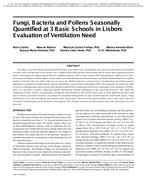Description
Nowadays, most individuals spend about 80% of their time indoor and, consequently, the exposure to the indoor environment becomes more relevant than to the outdoor one. Children spend most of their time at home and at school and evaluations of their indoor environment are important for the time-weighted exposure. Due to their airways still in development, children are a sensitive group with higher risk than adults. Larger impact in health and educational performance of children demand indoor air quality studies of schools. The aim of this study was to assess the children exposure to bioaerosols. A methodology based upon passive sampling was applied to evaluate fungi, bacteria and pollens; its procedures and applicability was optimized. An indoor air study by passive sampling represents an easier and cheaper method when comparing with the use of automatic active samplers. Furthermore, it is possible to achieve important quality information without interfering in the classroom activities. The study was conducted in three schools, representative of different environments in the Lisbon urban area, at three different periods of the year to obtain a seasonal variation, to estimate the variability through the city and to understand the underneath causes. Fungi and bacteria were collected indoor and outdoor of the classrooms to determine the indoor/outdoor ratios and to assess the level of outdoor contamination upon the indoor environment. The children’s exposure to pollen grains inside the classrooms was also assessed.
Citation: IAQ Conference: IAQ 2010: Airborne Infection Control
Product Details
- Published:
- 2011
- Number of Pages:
- 12
- File Size:
- 1 file , 680 KB
- Product Code(s):
- D-IAQ2010-C129-10




